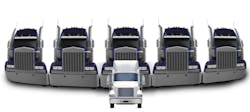What’s the biggest challenge facing many single-truck operations? Changing their paradigm from being a trucker to being a trucking company.
Present your truck as a “trucking company.” When talking to potential customers, it’s very important you walk, talk, and present yourself as a company account executive. Making a strong first impression is key, and having a great attitude will help. You must present yourself in the best possible manner, one that will place you ahead of the competition. If you act like an executive of a larger trucking company, then you’ll be treated like one.
Deal directly with shipping customers and quality brokers who represent quality shippers. This doesn’t mean that you should never work off load boards, but do it as seldom as possible. Focus on creating a truck-to-load saturation that has more loads available than you have trucks.
What’s truck-to-load saturation? It’s the law of supply and demand. In trucking, if you have more trucks than loads your rates will be lower; more loads than trucks bring higher rates. So your objective should be having more loads available than you have trucks.
Once you’ve landed quality shipping customers, your next objective is to be competitive in quality of service: Don’t try to compete on price. There will always be another trucker out there willing to haul that load cheaper than you can. So why even try to compete there? By providing top quality, go-out-of-your-way service, that “can do” approach makes it nearly impossible for someone trying to compete with a lower price to take your customer. Think in terms of “raving fans,” not just satisfied customers. Create a demand for your services and the shipping customers will line up to do business with you. And you will be on your way to having more loads than trucks.
Don’t wait until the last minute to look for a load. If you appear to be desperate, the shipper, or worse, the broker, will low-ball the rate. Always have more loads than trucks. Constantly be on the hunt for new customers to create truck-to-load saturation in your favor. If you have to look for loads at the last minute, then you’ve failed in one of two areas:
- You’ve traveled out of your niche area into unknown territory. Don’t do this unless you’re getting a rate that pays enough so you can return empty to your niche area and still show a reasonable profit on the load (at a minimum, you need to charge a round-trip rate).
- You haven’t reached your truck-to-load saturation objective, and you need to find more customers.
Running your own trucking company is a challenge, especially with just one or two trucks, but if it’s done with proper planning and effort, it can be very rewarding.
Remember, just as in any other business, to be successful you need to find a niche and fill it.
Contact Tim Brady at 731-749-8567 or at www.timothybrady.com
About the Author

Timothy Brady
Timothy Brady is an author, columnist, speaker, and business coach who provides information, training, and educational presentations for small to large trucking companies, logistics organizations, and community groups. After 25 years in trucking, Brady held positions from company driver to owner-operator to small trucking business owner.
